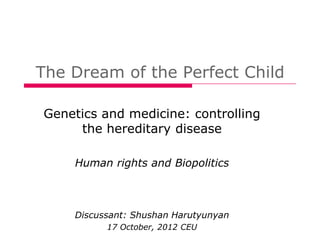
The Dream of the Perfect Child, Human rights and Biopolitics
- 1. The Dream of the Perfect Child Genetics and medicine: controlling the hereditary disease Human rights and Biopolitics Discussant: Shushan Harutyunyan 17 October, 2012 CEU
- 2. Joan Rothschild Joan Rothschild, educator and author, is best known for her work in the field of ―gender and technology.‖ She is author-editor of Machina Ex Dea: Feminist Perspectives on Technology published in 1983; guest editor of Technology and Feminism, special issue of Research in Philosophy and Technology (1993); author of Teaching Technology from a Feminist Perspective (1988); and author-editor of Design and Feminism: Re-Visioning Spaces, Places, and Everyday Things (1999). ―I'm living happily without a car, busily writing, and enjoying the pleasures and vistas of the city of my birth. I have a B.A. in English from Cornell University, and an M.A. and Ph.D. in politics from NYU. I had an earlier career before academe in print media at The New York Herald Tribune and Scholastic Magazines, experience that saved me from the horrors of academic prose. My books are readable!‖ Information from Amazon.com and from her personal website.
- 3. The Dream of the Perfect Child Published in spring 2005 by Indiana University Press, USA.343 pp, her sixth book The culmination of over 15 years of research, the book places the contemporary quest for the perfect child into historical perspective, tracing the intersection of science, technology, and medicine with the ideology of human perfectibility from the Enlightenment to the present, as genetics, reproductive technologies, and perfectibility ideology meet in today’s medical practice‖ Quotation from her biography in institute for advanced studies on science, technology and society (ias- sts) official website
- 4. Mix of history, science and technology studies, and ethical analysis The eugenic agenda of the eighteenth through the mid-twentieth centuries has been relocated to the private, domesticated space of the clinic and the discourse of individualized medical decision making, and thereby strengthened. ―The discourse of the perfect child is neither scientific-medical conspiracy nor male plot." Rather, "technology, medicine, and parental expectations intersect to distort the desire for normal, healthy babies into the dream of perfect ones"—a desire that she argues is both understandable and appropriate (227). The first three chapters are an informative and helpful history of the idea that humans can be perfected through science, medicine, and social policy. The fourth chapter is a useful primer on genetics and prenatal diagnostic technologies, which is accessible to a humanities audience but not overly simplistic. Source of the information: The Dream of the Perfect Child (review), Rebecca Kukla, Hypatia , Volume 22, Number 4, Fall 2007 http://muse.jhu.edu/login?auth=0&type=summary&url=/journals/hypatia/v022/22.4kukla.pdf
- 5. Genetics and ―visionary perfection‖ Old eugenics movements trying to woo the medical profession in 1960s. But physicians sympathetic to eugenics were attached to it as social movement, rather than as a science. Training in genetics and eugenics to be incorporated into the medical school curriculum. (Third international congress of eugenics) ―Preventive medicine‖, ―Pre-conceptional care‖ “Your DNA contains - genetic counseling, use of family the mysteries of pedigrees, health examination marriage – to many areas of your life including your bring human beings to ―visionary perfection‖. medical tendencies” Photo source and explanation of it from eHow.com
- 6. Changes in discourse Research in human genetics began to discover the genetic foundations of some hereditary diseases Physicians become involved in research of human genetic diseases; medical genetics becomes a field of its own rights (1950s) which involves reproductive medicine. The discourse would come to reflect changed balance of private aims, social concerns and ideology.
- 7. ―Patient-oriented‖ approach VS societal eugenic genetic concerns In the clinical settings of reproductive medicine, the decision to bear or not to bear a child with a possible birth defect was individual, private, involving only the physician and the parent(s). But… when the linkup of medicine and genetics ―finally‖ come arose out of professional interests of requirements of physicians themselves Yet, in the transition period, as doctors become more involved with genetics and hereditary diseases and engaged in genetic consulting, the reformulated eugenic agenda continued to play a part in the emerging practice of genetically oriented reproductive medicine. When genetic counseling developed into a profession in 1970s and 80s, it called for a ―non-directive‖ model. Physicians individual, patient-oriented approach would not be fully separated from the societal eugenic genetic concerns.
- 8. THANK YOU
